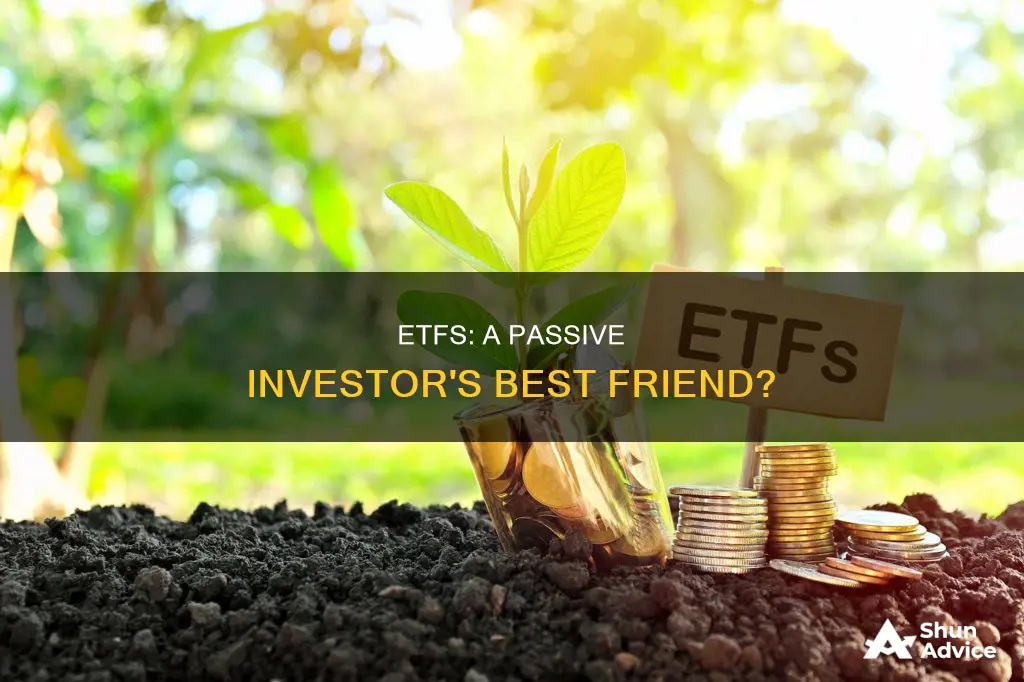
Exchange-traded funds (ETFs) are a popular investment vehicle that has been around since the 1990s. They are a collection or basket of individual stocks or bonds and can be either passively or actively managed. Passive ETFs are a popular strategy for investors who prefer a long-term, buy-and-hold approach, as they aim to track a specific index and involve limited transactions. On the other hand, active ETFs involve fund managers actively trading securities to try to outperform an index. Passive ETFs tend to have lower management fees and are more transparent, but they don't offer the potential for outperformance.
What You'll Learn
- Passive ETFs are a popular strategy for investors who prefer a long-term, buy-and-hold approach
- Passive ETFs tend to follow a buy-and-hold strategy to track a benchmark
- Passive ETFs tend to be lower-cost and more transparent than active ETFs
- Passive ETFs are known for their cost-efficiency and lower management fees
- Passive ETFs are designed to track an index

Passive ETFs are a popular strategy for investors who prefer a long-term, buy-and-hold approach
Passive ETFs have existed since 1993 and have grown in popularity due to their low cost, broad diversification, and ease of access. They are often used by investors who want to implement a passive investment strategy, buying and holding securities for the long term. Passive ETFs also provide intraday trading, allowing investors to buy and sell throughout the day, just like individual stocks. This provides investors with more control over their investments.
Additionally, passive ETFs tend to have lower management fees since they do not require active decision-making. According to Morningstar, most actively managed funds fail to outperform their benchmarks or passive ETF counterparts, especially over longer periods. This makes passive ETFs a more attractive option for those seeking a long-term investment strategy.
It is important to note that passive ETFs may face tracking errors, where their returns deviate from the index they are tracking due to factors like expenses, trading costs, and liquidity risk. However, passive ETFs still offer a cost-efficient and diversified investment strategy, making them a popular choice for long-term investors.
Understanding Quicken: Cash and Investments Reconciliation Issues
You may want to see also

Passive ETFs tend to follow a buy-and-hold strategy to track a benchmark
Passive ETFs are a popular investment strategy for those who prefer a long-term, buy-and-hold approach. They are designed to track a specific benchmark or index, such as the S&P 500 or Nasdaq Composite Index, and provide investors with exposure to a wide range of asset classes. This means that passive ETFs tend to follow a buy-and-hold strategy, only making allocation decisions or trades that take place within the index itself. This passive approach aims to minimise costs and closely mirror the returns of the chosen benchmark, rather than aiming to outperform it.
Passive ETFs are often chosen for their low management fees, transparency, and broad diversification. They are also known for their cost-efficiency, as they generally have lower management fees than active ETFs. This is because passive ETFs aim to replicate the performance of a benchmark without requiring active decision-making. The passive approach also means there is less administrative fee as most passive ETFs follow a rules-based approach, avoiding the costs associated with active research and security selection.
However, passive ETFs may face tracking errors, where their returns deviate from the benchmark due to factors like expenses, trading costs, and liquidity risk. Additionally, passive ETFs do not provide any opportunity for outperformance and may not be suitable for investors seeking to beat the market.
In contrast, active ETFs utilise a portfolio manager's investment strategy and actively trade securities to try to outperform a benchmark. Active ETFs may be more suitable for investors seeking the potential for higher returns than what the broad market or specific indexes offer.
Securities Sales: Investment Activity or Cash Flow?
You may want to see also

Passive ETFs tend to be lower-cost and more transparent than active ETFs
Exchange-traded funds (ETFs) have become an increasingly popular investment vehicle since their introduction in the 1990s. ETFs can be either passively or actively managed. While active ETFs involve fund managers actively trading securities to outperform a benchmark, passive ETFs follow a buy-and-hold strategy to track a particular index.
Passive ETFs tend to be lower-cost than active ETFs. This is because passive ETFs do not involve active fund management, which requires ongoing research, trading, and security selection. Instead, passive ETFs aim to replicate the performance of a specific benchmark index without requiring active decision-making. As a result, passive ETFs have lower management fees and expense ratios. The absence of active fund management also means that passive ETFs are more cost-efficient, with reduced transaction costs and brokerage fees.
Passive ETFs are also more transparent than active ETFs. Passive ETF providers publish fund weightings daily, allowing investors to limit strategy drift and identify duplicate investments. On the other hand, active ETFs are not required to disclose their holdings daily, creating a lack of transparency around their investment strategies.
In summary, passive ETFs offer investors a lower-cost and more transparent investment option compared to active ETFs. However, passive ETFs do not provide the potential for outperformance and may be less flexible in responding to changing market conditions.
Cash Investments: Revenue or Not?
You may want to see also

Passive ETFs are known for their cost-efficiency and lower management fees
Passive ETFs are a popular investment strategy for those who prefer a long-term, buy-and-hold approach. They are designed to track a specific index or asset class and aim to replicate its performance without requiring active decision-making. This passive approach results in lower management fees compared to actively managed funds, as there is no fund manager trying to beat a benchmark. Instead, passive ETFs rely on a rules-based approach with limited transactions, which reduces administrative fees.
Passive ETFs also tend to have lower expense ratios than actively managed funds, and these savings can significantly impact total returns over time. Additionally, passive ETFs may generate fewer capital gains taxes due to their lower turnover and ability to use the in-kind creation/redemption process for managing the cost basis of their holdings.
While passive ETFs offer cost efficiency, it's important to consider other factors when investing. Passive ETFs may not provide the opportunity for outperformance and have tracking errors, resulting from deviations between the ETF's returns and the benchmark index's returns. Therefore, investors should evaluate a passive ETF's performance by assessing how closely it mirrors the index it aims to track.
Understanding Your Cash Available to Invest
You may want to see also

Passive ETFs are designed to track an index
Exchange-traded funds (ETFs) are a type of investment vehicle that has gained popularity since its introduction in the 1990s. Passive ETFs, in particular, are a popular choice for investors who prefer a long-term, buy-and-hold strategy. As the name suggests, passive ETFs are designed to passively track the performance of a specific index, such as the S&P 500 or Nasdaq Composite Index. This means that the fund's portfolio is constructed to mirror the underlying index, and any changes in the index are reflected in the ETF's portfolio.
Passive ETFs offer a convenient and low-cost way to implement passive investment management or indexing. They are well-suited for investors who want to buy and hold securities for the long term. By investing in a passive ETF, investors gain exposure to the entire market or a specific asset class represented by the underlying index. This provides broad diversification and reduces the risk associated with investing in individual stocks.
While passive ETFs aim to replicate the performance of an index, they may not always perfectly track it due to factors like expenses, trading costs, and tracking errors. Additionally, passive ETFs may face liquidity issues, especially when tracking relatively illiquid markets such as small-cap stocks and corporate bonds. To improve liquidity, passive ETFs may deviate from their underlying index, which can result in tracking errors and impact investor returns.
Despite these considerations, passive ETFs have consistently outperformed actively managed funds over the long term. They offer lower expense ratios, reducing overall costs and leaving more funds in the investor's portfolio. Passive ETFs also tend to be more tax-efficient than mutual funds, as investors do not pay taxes when the ETF portfolio is adjusted.
In summary, passive ETFs are designed to track an index by replicating its performance. They offer investors a simple, diversified, and cost-effective investment option, making them a popular choice for those seeking a long-term investment strategy.
Using the Long Position Tool on Investing.com: A Guide
You may want to see also
Frequently asked questions
Passive investing is an approach that focuses on tracking and achieving the return of a specific index. It involves limited transactions and is often associated with a long-term, buy-and-hold strategy.
ETF stands for Exchange-Traded Fund. ETFs are baskets of securities that can be traded on an exchange, providing investors with access to a wide range of asset classes.
ETFs can be used as a passive investment tool by tracking a specific index. Passive ETFs aim to replicate the performance of an index, such as the S&P 500, and are updated regularly to reflect changes in the reference index.
ETFs offer built-in diversification, low costs, and broad market exposure. They are also traded throughout the day, providing investors with more control over their investments.
ETFs may have higher management fees compared to passive index funds. Additionally, passive ETFs may deviate from their underlying index, resulting in tracking errors that impact investor returns.







